Principles of Business Report - Financial Management and Innovation
VerifiedAdded on 2020/07/22
|12
|3534
|461
Report
AI Summary
This report delves into the fundamental principles of business, examining various aspects essential for organizational success. It begins by analyzing different business markets, exploring the characteristics and interactions within each. The report then transitions to business innovation and growth, defining innovation, exploring various models, and discussing sources of support and guidance, along with the process, benefits, risks, and implications of product or service development. Financial management is also a central theme, emphasizing its importance, consequences of poor management, and key financial terminology. The report further examines business budgeting, its uses, and management. Finally, it covers marketing principles, sales processes, market research, brand value, and the relationship between sales and marketing. The report concludes with a synthesis of the key insights and findings, offering a comprehensive overview of core business principles.
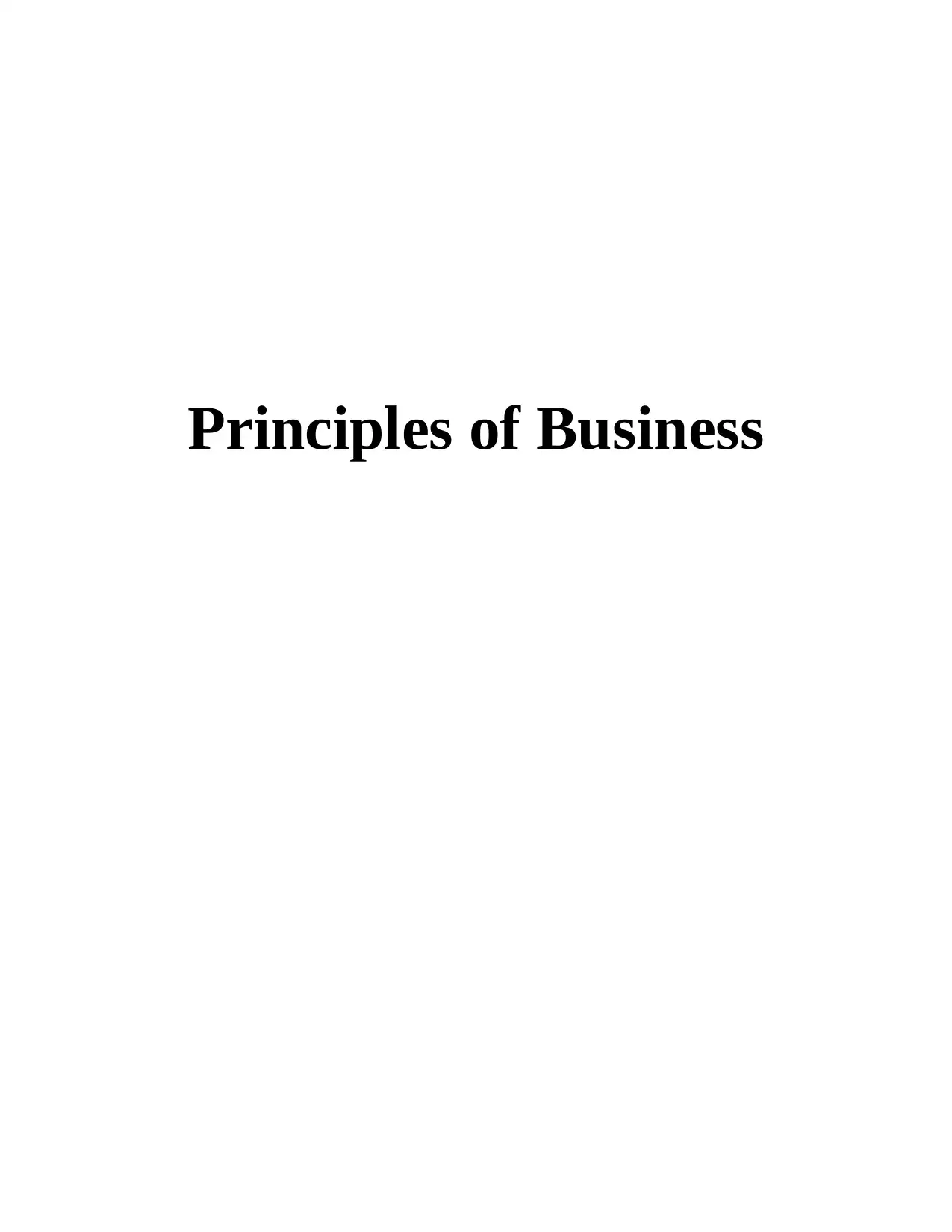
Principles of Business
Paraphrase This Document
Need a fresh take? Get an instant paraphrase of this document with our AI Paraphraser
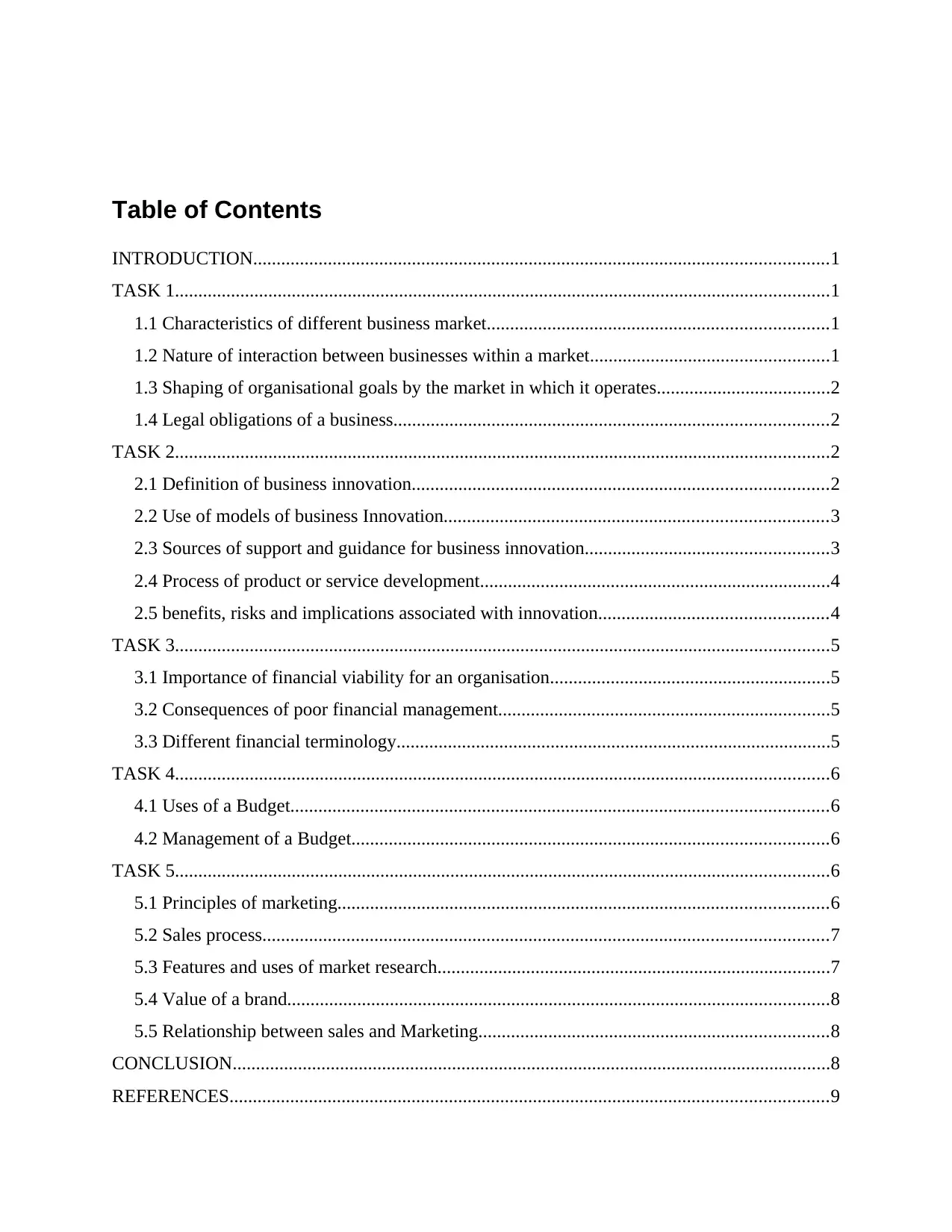
Table of Contents
INTRODUCTION...........................................................................................................................1
TASK 1............................................................................................................................................1
1.1 Characteristics of different business market.........................................................................1
1.2 Nature of interaction between businesses within a market...................................................1
1.3 Shaping of organisational goals by the market in which it operates.....................................2
1.4 Legal obligations of a business.............................................................................................2
TASK 2............................................................................................................................................2
2.1 Definition of business innovation.........................................................................................2
2.2 Use of models of business Innovation..................................................................................3
2.3 Sources of support and guidance for business innovation....................................................3
2.4 Process of product or service development...........................................................................4
2.5 benefits, risks and implications associated with innovation.................................................4
TASK 3............................................................................................................................................5
3.1 Importance of financial viability for an organisation............................................................5
3.2 Consequences of poor financial management.......................................................................5
3.3 Different financial terminology.............................................................................................5
TASK 4............................................................................................................................................6
4.1 Uses of a Budget...................................................................................................................6
4.2 Management of a Budget......................................................................................................6
TASK 5............................................................................................................................................6
5.1 Principles of marketing.........................................................................................................6
5.2 Sales process.........................................................................................................................7
5.3 Features and uses of market research....................................................................................7
5.4 Value of a brand....................................................................................................................8
5.5 Relationship between sales and Marketing...........................................................................8
CONCLUSION................................................................................................................................8
REFERENCES................................................................................................................................9
INTRODUCTION...........................................................................................................................1
TASK 1............................................................................................................................................1
1.1 Characteristics of different business market.........................................................................1
1.2 Nature of interaction between businesses within a market...................................................1
1.3 Shaping of organisational goals by the market in which it operates.....................................2
1.4 Legal obligations of a business.............................................................................................2
TASK 2............................................................................................................................................2
2.1 Definition of business innovation.........................................................................................2
2.2 Use of models of business Innovation..................................................................................3
2.3 Sources of support and guidance for business innovation....................................................3
2.4 Process of product or service development...........................................................................4
2.5 benefits, risks and implications associated with innovation.................................................4
TASK 3............................................................................................................................................5
3.1 Importance of financial viability for an organisation............................................................5
3.2 Consequences of poor financial management.......................................................................5
3.3 Different financial terminology.............................................................................................5
TASK 4............................................................................................................................................6
4.1 Uses of a Budget...................................................................................................................6
4.2 Management of a Budget......................................................................................................6
TASK 5............................................................................................................................................6
5.1 Principles of marketing.........................................................................................................6
5.2 Sales process.........................................................................................................................7
5.3 Features and uses of market research....................................................................................7
5.4 Value of a brand....................................................................................................................8
5.5 Relationship between sales and Marketing...........................................................................8
CONCLUSION................................................................................................................................8
REFERENCES................................................................................................................................9
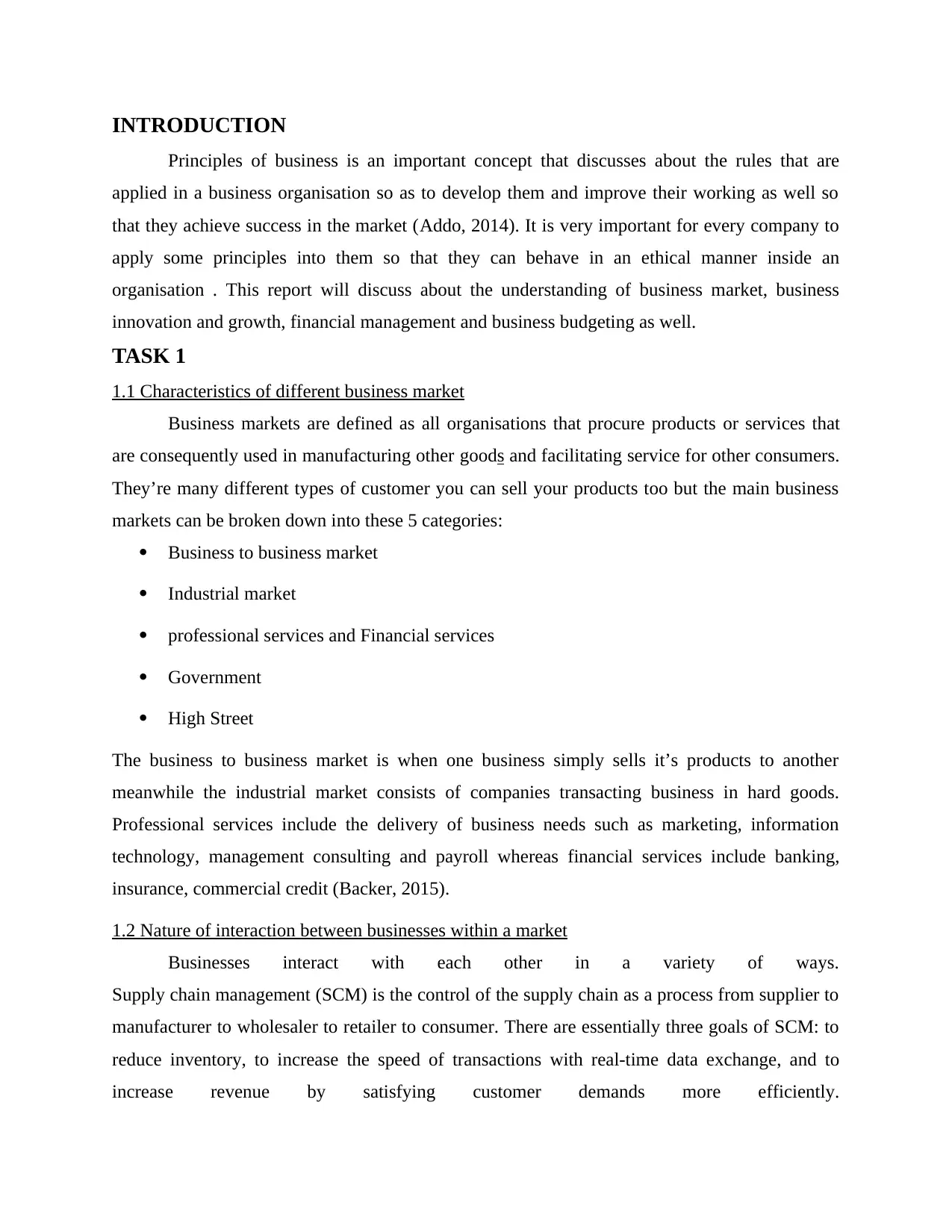
INTRODUCTION
Principles of business is an important concept that discusses about the rules that are
applied in a business organisation so as to develop them and improve their working as well so
that they achieve success in the market (Addo, 2014). It is very important for every company to
apply some principles into them so that they can behave in an ethical manner inside an
organisation . This report will discuss about the understanding of business market, business
innovation and growth, financial management and business budgeting as well.
TASK 1
1.1 Characteristics of different business market
Business markets are defined as all organisations that procure products or services that
are consequently used in manufacturing other goods and facilitating service for other consumers.
They’re many different types of customer you can sell your products too but the main business
markets can be broken down into these 5 categories:
Business to business market
Industrial market
professional services and Financial services
Government
High Street
The business to business market is when one business simply sells it’s products to another
meanwhile the industrial market consists of companies transacting business in hard goods.
Professional services include the delivery of business needs such as marketing, information
technology, management consulting and payroll whereas financial services include banking,
insurance, commercial credit (Backer, 2015).
1.2 Nature of interaction between businesses within a market
Businesses interact with each other in a variety of ways.
Supply chain management (SCM) is the control of the supply chain as a process from supplier to
manufacturer to wholesaler to retailer to consumer. There are essentially three goals of SCM: to
reduce inventory, to increase the speed of transactions with real-time data exchange, and to
increase revenue by satisfying customer demands more efficiently.
Principles of business is an important concept that discusses about the rules that are
applied in a business organisation so as to develop them and improve their working as well so
that they achieve success in the market (Addo, 2014). It is very important for every company to
apply some principles into them so that they can behave in an ethical manner inside an
organisation . This report will discuss about the understanding of business market, business
innovation and growth, financial management and business budgeting as well.
TASK 1
1.1 Characteristics of different business market
Business markets are defined as all organisations that procure products or services that
are consequently used in manufacturing other goods and facilitating service for other consumers.
They’re many different types of customer you can sell your products too but the main business
markets can be broken down into these 5 categories:
Business to business market
Industrial market
professional services and Financial services
Government
High Street
The business to business market is when one business simply sells it’s products to another
meanwhile the industrial market consists of companies transacting business in hard goods.
Professional services include the delivery of business needs such as marketing, information
technology, management consulting and payroll whereas financial services include banking,
insurance, commercial credit (Backer, 2015).
1.2 Nature of interaction between businesses within a market
Businesses interact with each other in a variety of ways.
Supply chain management (SCM) is the control of the supply chain as a process from supplier to
manufacturer to wholesaler to retailer to consumer. There are essentially three goals of SCM: to
reduce inventory, to increase the speed of transactions with real-time data exchange, and to
increase revenue by satisfying customer demands more efficiently.
⊘ This is a preview!⊘
Do you want full access?
Subscribe today to unlock all pages.

Trusted by 1+ million students worldwide
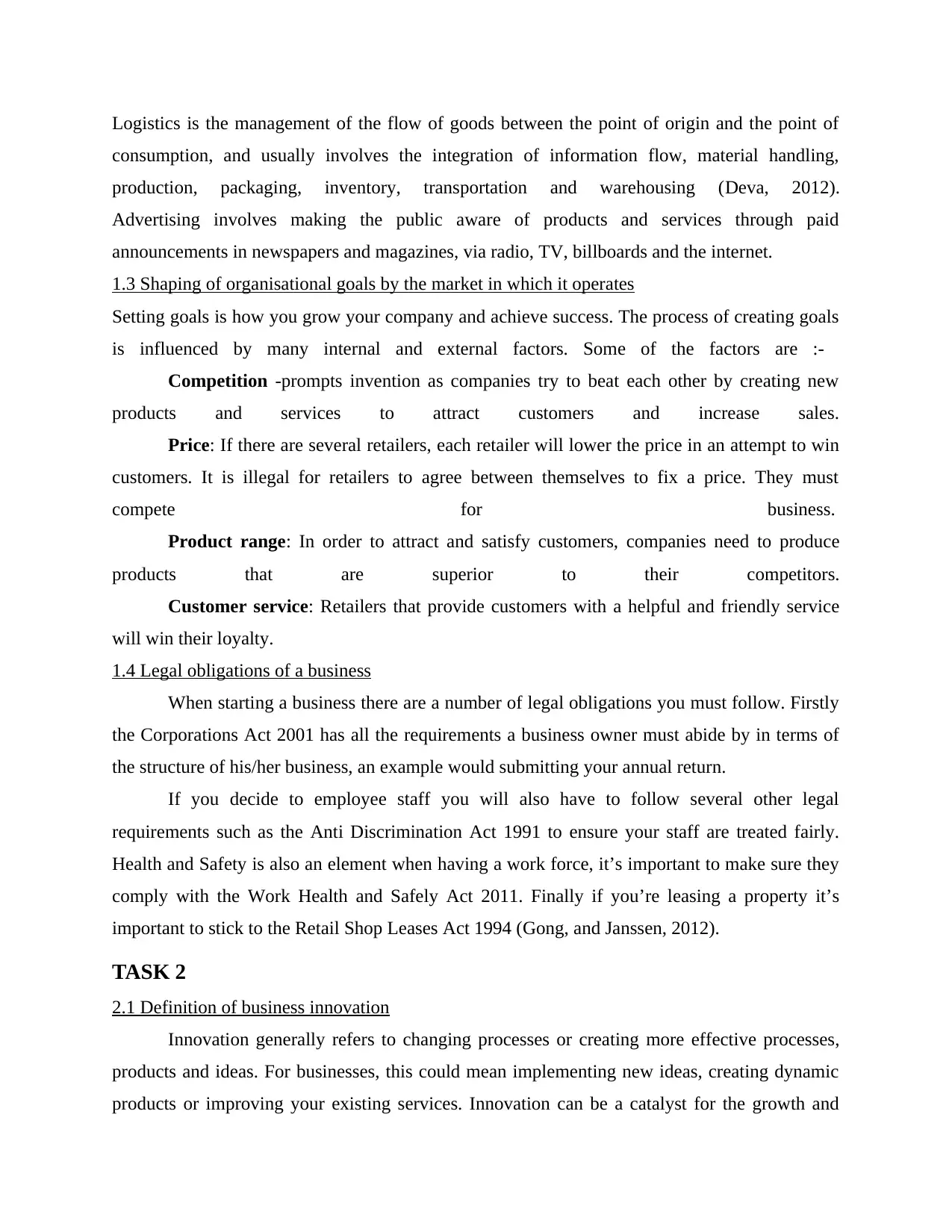
Logistics is the management of the flow of goods between the point of origin and the point of
consumption, and usually involves the integration of information flow, material handling,
production, packaging, inventory, transportation and warehousing (Deva, 2012).
Advertising involves making the public aware of products and services through paid
announcements in newspapers and magazines, via radio, TV, billboards and the internet.
1.3 Shaping of organisational goals by the market in which it operates
Setting goals is how you grow your company and achieve success. The process of creating goals
is influenced by many internal and external factors. Some of the factors are :-
Competition -prompts invention as companies try to beat each other by creating new
products and services to attract customers and increase sales.
Price: If there are several retailers, each retailer will lower the price in an attempt to win
customers. It is illegal for retailers to agree between themselves to fix a price. They must
compete for business.
Product range: In order to attract and satisfy customers, companies need to produce
products that are superior to their competitors.
Customer service: Retailers that provide customers with a helpful and friendly service
will win their loyalty.
1.4 Legal obligations of a business
When starting a business there are a number of legal obligations you must follow. Firstly
the Corporations Act 2001 has all the requirements a business owner must abide by in terms of
the structure of his/her business, an example would submitting your annual return.
If you decide to employee staff you will also have to follow several other legal
requirements such as the Anti Discrimination Act 1991 to ensure your staff are treated fairly.
Health and Safety is also an element when having a work force, it’s important to make sure they
comply with the Work Health and Safely Act 2011. Finally if you’re leasing a property it’s
important to stick to the Retail Shop Leases Act 1994 (Gong, and Janssen, 2012).
TASK 2
2.1 Definition of business innovation
Innovation generally refers to changing processes or creating more effective processes,
products and ideas. For businesses, this could mean implementing new ideas, creating dynamic
products or improving your existing services. Innovation can be a catalyst for the growth and
consumption, and usually involves the integration of information flow, material handling,
production, packaging, inventory, transportation and warehousing (Deva, 2012).
Advertising involves making the public aware of products and services through paid
announcements in newspapers and magazines, via radio, TV, billboards and the internet.
1.3 Shaping of organisational goals by the market in which it operates
Setting goals is how you grow your company and achieve success. The process of creating goals
is influenced by many internal and external factors. Some of the factors are :-
Competition -prompts invention as companies try to beat each other by creating new
products and services to attract customers and increase sales.
Price: If there are several retailers, each retailer will lower the price in an attempt to win
customers. It is illegal for retailers to agree between themselves to fix a price. They must
compete for business.
Product range: In order to attract and satisfy customers, companies need to produce
products that are superior to their competitors.
Customer service: Retailers that provide customers with a helpful and friendly service
will win their loyalty.
1.4 Legal obligations of a business
When starting a business there are a number of legal obligations you must follow. Firstly
the Corporations Act 2001 has all the requirements a business owner must abide by in terms of
the structure of his/her business, an example would submitting your annual return.
If you decide to employee staff you will also have to follow several other legal
requirements such as the Anti Discrimination Act 1991 to ensure your staff are treated fairly.
Health and Safety is also an element when having a work force, it’s important to make sure they
comply with the Work Health and Safely Act 2011. Finally if you’re leasing a property it’s
important to stick to the Retail Shop Leases Act 1994 (Gong, and Janssen, 2012).
TASK 2
2.1 Definition of business innovation
Innovation generally refers to changing processes or creating more effective processes,
products and ideas. For businesses, this could mean implementing new ideas, creating dynamic
products or improving your existing services. Innovation can be a catalyst for the growth and
Paraphrase This Document
Need a fresh take? Get an instant paraphrase of this document with our AI Paraphraser
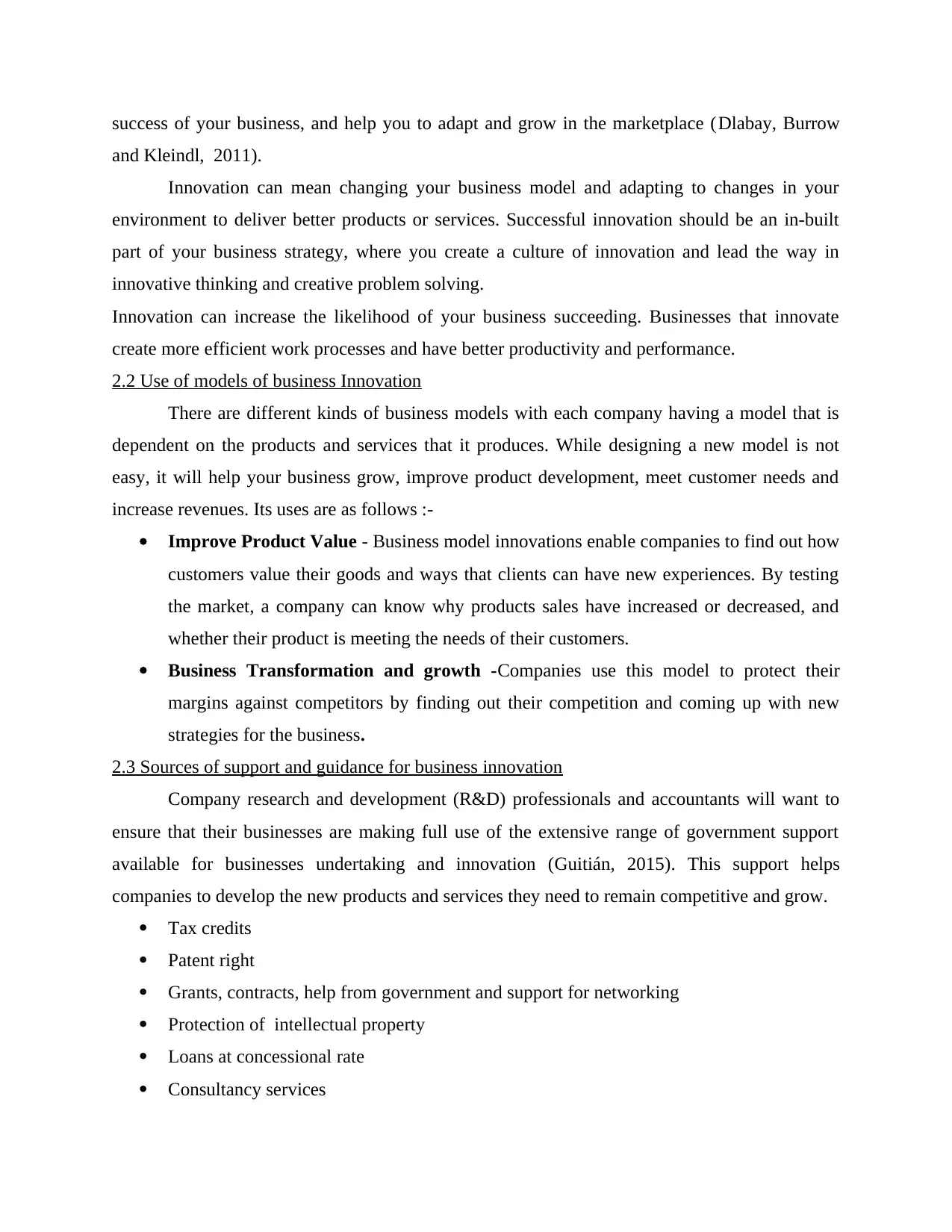
success of your business, and help you to adapt and grow in the marketplace (Dlabay, Burrow
and Kleindl, 2011).
Innovation can mean changing your business model and adapting to changes in your
environment to deliver better products or services. Successful innovation should be an in-built
part of your business strategy, where you create a culture of innovation and lead the way in
innovative thinking and creative problem solving.
Innovation can increase the likelihood of your business succeeding. Businesses that innovate
create more efficient work processes and have better productivity and performance.
2.2 Use of models of business Innovation
There are different kinds of business models with each company having a model that is
dependent on the products and services that it produces. While designing a new model is not
easy, it will help your business grow, improve product development, meet customer needs and
increase revenues. Its uses are as follows :-
Improve Product Value - Business model innovations enable companies to find out how
customers value their goods and ways that clients can have new experiences. By testing
the market, a company can know why products sales have increased or decreased, and
whether their product is meeting the needs of their customers.
Business Transformation and growth -Companies use this model to protect their
margins against competitors by finding out their competition and coming up with new
strategies for the business.
2.3 Sources of support and guidance for business innovation
Company research and development (R&D) professionals and accountants will want to
ensure that their businesses are making full use of the extensive range of government support
available for businesses undertaking and innovation (Guitián, 2015). This support helps
companies to develop the new products and services they need to remain competitive and grow.
Tax credits
Patent right
Grants, contracts, help from government and support for networking
Protection of intellectual property
Loans at concessional rate
Consultancy services
and Kleindl, 2011).
Innovation can mean changing your business model and adapting to changes in your
environment to deliver better products or services. Successful innovation should be an in-built
part of your business strategy, where you create a culture of innovation and lead the way in
innovative thinking and creative problem solving.
Innovation can increase the likelihood of your business succeeding. Businesses that innovate
create more efficient work processes and have better productivity and performance.
2.2 Use of models of business Innovation
There are different kinds of business models with each company having a model that is
dependent on the products and services that it produces. While designing a new model is not
easy, it will help your business grow, improve product development, meet customer needs and
increase revenues. Its uses are as follows :-
Improve Product Value - Business model innovations enable companies to find out how
customers value their goods and ways that clients can have new experiences. By testing
the market, a company can know why products sales have increased or decreased, and
whether their product is meeting the needs of their customers.
Business Transformation and growth -Companies use this model to protect their
margins against competitors by finding out their competition and coming up with new
strategies for the business.
2.3 Sources of support and guidance for business innovation
Company research and development (R&D) professionals and accountants will want to
ensure that their businesses are making full use of the extensive range of government support
available for businesses undertaking and innovation (Guitián, 2015). This support helps
companies to develop the new products and services they need to remain competitive and grow.
Tax credits
Patent right
Grants, contracts, help from government and support for networking
Protection of intellectual property
Loans at concessional rate
Consultancy services

2.4 Process of product or service development
1. Idea generation– Brainstorming and coming up with innovative new ideas. See
generating ideas for new product and development.
2. Idea evaluation- Filtering out any ideas not worth taking forward. See screening of new
product and service idea.
3. Feasibility study- Considering specifications such as product design, market potential.
See researching new product and services ideas (Li, Adeli, Sun and Han, 2011).
4. Strategic analysis- Ensuring your ideas fit into your business' strategic plans and
determining the demand, the costs and the profit margin.
5. Product development and testing- Creating a prototype product or pilot service. See
concept development and testing.
6. Market testing- modifying the product or service according to customer, manufacturer
and support organisations' feedback. This involves deciding the best timing and process
for piloting your new product or service. See how to test the market.
7. Commercialisation– determining the pricing for your product or service and finalising
marketing plans. See pricing proposed service or product.
8. Product launch– a detailed launch plan can help ensure smooth introduction to market.
2.5 benefits, risks and implications associated with innovation
BENEFITS OF INNOVATION:-
IMPROVED PRODUCTIVITY AND REDUCED COSTS
A lot of process innovation is about reducing unit costs.
BETTER QUALITY
Better quality products and services are more likely to meet customer needs.
TO HANDLE LEGAL AND ENVIROMENTAL ISSUES
Changes in law often force business to innovate when they might not do so (Lübbe, 2011).
MORE ADDED VALUE
Effective innovation is a great way to establish a unique selling proposition (USP).
IMPROVED STAFF RETENTION, MOTIVATION AND EASIER RECRUITMENT
Potential good quality recruits are often drawn to a business with a reputation for innovation.
1. Idea generation– Brainstorming and coming up with innovative new ideas. See
generating ideas for new product and development.
2. Idea evaluation- Filtering out any ideas not worth taking forward. See screening of new
product and service idea.
3. Feasibility study- Considering specifications such as product design, market potential.
See researching new product and services ideas (Li, Adeli, Sun and Han, 2011).
4. Strategic analysis- Ensuring your ideas fit into your business' strategic plans and
determining the demand, the costs and the profit margin.
5. Product development and testing- Creating a prototype product or pilot service. See
concept development and testing.
6. Market testing- modifying the product or service according to customer, manufacturer
and support organisations' feedback. This involves deciding the best timing and process
for piloting your new product or service. See how to test the market.
7. Commercialisation– determining the pricing for your product or service and finalising
marketing plans. See pricing proposed service or product.
8. Product launch– a detailed launch plan can help ensure smooth introduction to market.
2.5 benefits, risks and implications associated with innovation
BENEFITS OF INNOVATION:-
IMPROVED PRODUCTIVITY AND REDUCED COSTS
A lot of process innovation is about reducing unit costs.
BETTER QUALITY
Better quality products and services are more likely to meet customer needs.
TO HANDLE LEGAL AND ENVIROMENTAL ISSUES
Changes in law often force business to innovate when they might not do so (Lübbe, 2011).
MORE ADDED VALUE
Effective innovation is a great way to establish a unique selling proposition (USP).
IMPROVED STAFF RETENTION, MOTIVATION AND EASIER RECRUITMENT
Potential good quality recruits are often drawn to a business with a reputation for innovation.
⊘ This is a preview!⊘
Do you want full access?
Subscribe today to unlock all pages.

Trusted by 1+ million students worldwide
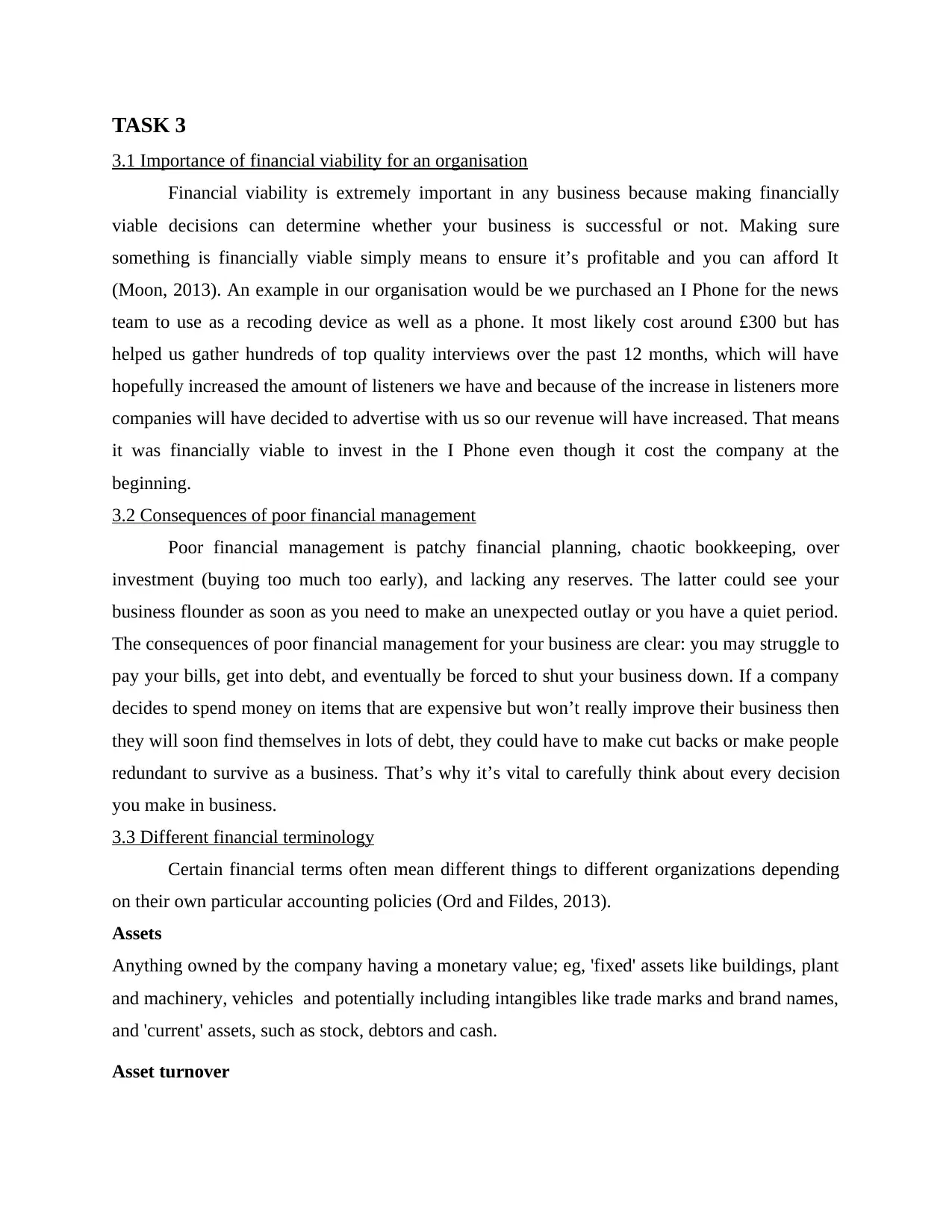
TASK 3
3.1 Importance of financial viability for an organisation
Financial viability is extremely important in any business because making financially
viable decisions can determine whether your business is successful or not. Making sure
something is financially viable simply means to ensure it’s profitable and you can afford It
(Moon, 2013). An example in our organisation would be we purchased an I Phone for the news
team to use as a recoding device as well as a phone. It most likely cost around £300 but has
helped us gather hundreds of top quality interviews over the past 12 months, which will have
hopefully increased the amount of listeners we have and because of the increase in listeners more
companies will have decided to advertise with us so our revenue will have increased. That means
it was financially viable to invest in the I Phone even though it cost the company at the
beginning.
3.2 Consequences of poor financial management
Poor financial management is patchy financial planning, chaotic bookkeeping, over
investment (buying too much too early), and lacking any reserves. The latter could see your
business flounder as soon as you need to make an unexpected outlay or you have a quiet period.
The consequences of poor financial management for your business are clear: you may struggle to
pay your bills, get into debt, and eventually be forced to shut your business down. If a company
decides to spend money on items that are expensive but won’t really improve their business then
they will soon find themselves in lots of debt, they could have to make cut backs or make people
redundant to survive as a business. That’s why it’s vital to carefully think about every decision
you make in business.
3.3 Different financial terminology
Certain financial terms often mean different things to different organizations depending
on their own particular accounting policies (Ord and Fildes, 2013).
Assets
Anything owned by the company having a monetary value; eg, 'fixed' assets like buildings, plant
and machinery, vehicles and potentially including intangibles like trade marks and brand names,
and 'current' assets, such as stock, debtors and cash.
Asset turnover
3.1 Importance of financial viability for an organisation
Financial viability is extremely important in any business because making financially
viable decisions can determine whether your business is successful or not. Making sure
something is financially viable simply means to ensure it’s profitable and you can afford It
(Moon, 2013). An example in our organisation would be we purchased an I Phone for the news
team to use as a recoding device as well as a phone. It most likely cost around £300 but has
helped us gather hundreds of top quality interviews over the past 12 months, which will have
hopefully increased the amount of listeners we have and because of the increase in listeners more
companies will have decided to advertise with us so our revenue will have increased. That means
it was financially viable to invest in the I Phone even though it cost the company at the
beginning.
3.2 Consequences of poor financial management
Poor financial management is patchy financial planning, chaotic bookkeeping, over
investment (buying too much too early), and lacking any reserves. The latter could see your
business flounder as soon as you need to make an unexpected outlay or you have a quiet period.
The consequences of poor financial management for your business are clear: you may struggle to
pay your bills, get into debt, and eventually be forced to shut your business down. If a company
decides to spend money on items that are expensive but won’t really improve their business then
they will soon find themselves in lots of debt, they could have to make cut backs or make people
redundant to survive as a business. That’s why it’s vital to carefully think about every decision
you make in business.
3.3 Different financial terminology
Certain financial terms often mean different things to different organizations depending
on their own particular accounting policies (Ord and Fildes, 2013).
Assets
Anything owned by the company having a monetary value; eg, 'fixed' assets like buildings, plant
and machinery, vehicles and potentially including intangibles like trade marks and brand names,
and 'current' assets, such as stock, debtors and cash.
Asset turnover
Paraphrase This Document
Need a fresh take? Get an instant paraphrase of this document with our AI Paraphraser
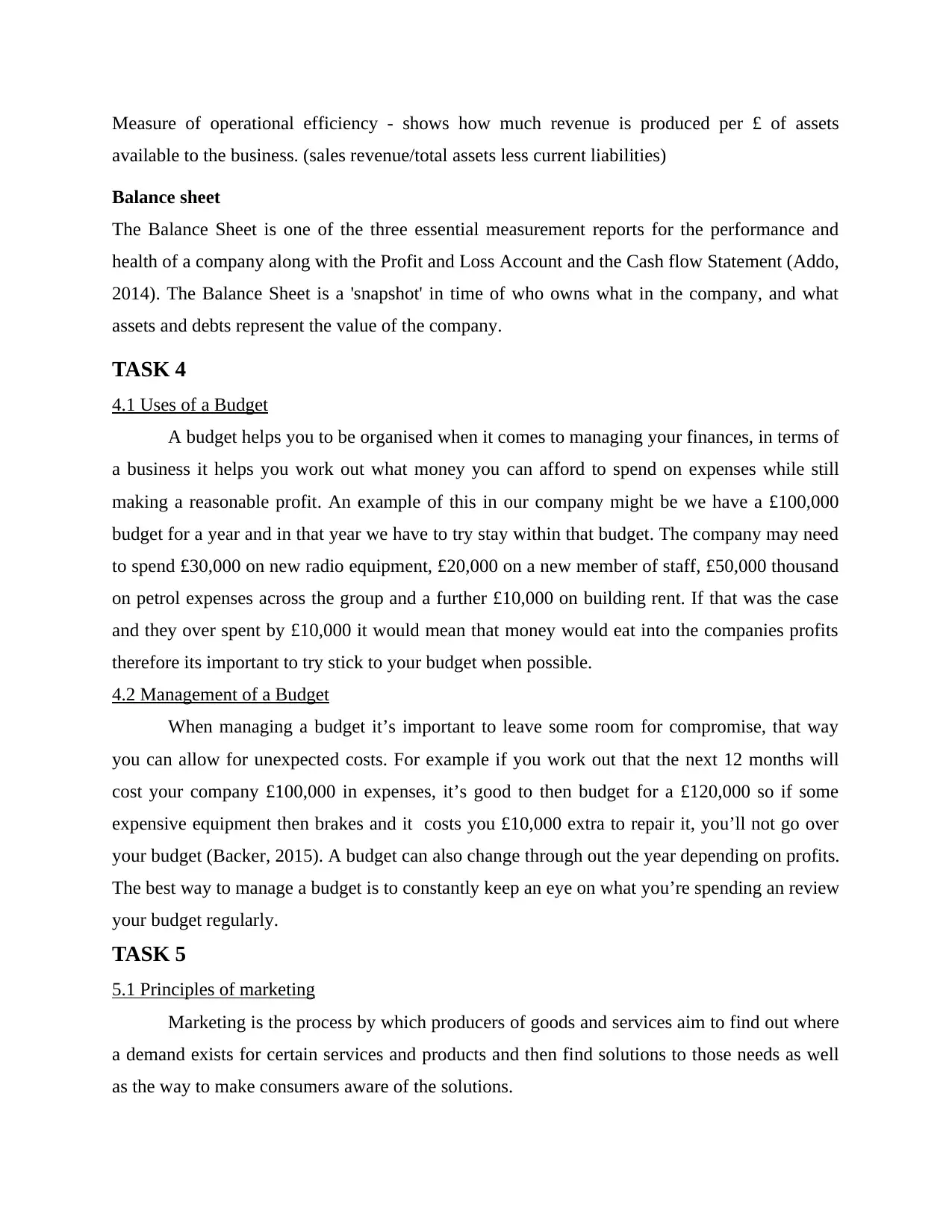
Measure of operational efficiency - shows how much revenue is produced per £ of assets
available to the business. (sales revenue/total assets less current liabilities)
Balance sheet
The Balance Sheet is one of the three essential measurement reports for the performance and
health of a company along with the Profit and Loss Account and the Cash flow Statement (Addo,
2014). The Balance Sheet is a 'snapshot' in time of who owns what in the company, and what
assets and debts represent the value of the company.
TASK 4
4.1 Uses of a Budget
A budget helps you to be organised when it comes to managing your finances, in terms of
a business it helps you work out what money you can afford to spend on expenses while still
making a reasonable profit. An example of this in our company might be we have a £100,000
budget for a year and in that year we have to try stay within that budget. The company may need
to spend £30,000 on new radio equipment, £20,000 on a new member of staff, £50,000 thousand
on petrol expenses across the group and a further £10,000 on building rent. If that was the case
and they over spent by £10,000 it would mean that money would eat into the companies profits
therefore its important to try stick to your budget when possible.
4.2 Management of a Budget
When managing a budget it’s important to leave some room for compromise, that way
you can allow for unexpected costs. For example if you work out that the next 12 months will
cost your company £100,000 in expenses, it’s good to then budget for a £120,000 so if some
expensive equipment then brakes and it costs you £10,000 extra to repair it, you’ll not go over
your budget (Backer, 2015). A budget can also change through out the year depending on profits.
The best way to manage a budget is to constantly keep an eye on what you’re spending an review
your budget regularly.
TASK 5
5.1 Principles of marketing
Marketing is the process by which producers of goods and services aim to find out where
a demand exists for certain services and products and then find solutions to those needs as well
as the way to make consumers aware of the solutions.
available to the business. (sales revenue/total assets less current liabilities)
Balance sheet
The Balance Sheet is one of the three essential measurement reports for the performance and
health of a company along with the Profit and Loss Account and the Cash flow Statement (Addo,
2014). The Balance Sheet is a 'snapshot' in time of who owns what in the company, and what
assets and debts represent the value of the company.
TASK 4
4.1 Uses of a Budget
A budget helps you to be organised when it comes to managing your finances, in terms of
a business it helps you work out what money you can afford to spend on expenses while still
making a reasonable profit. An example of this in our company might be we have a £100,000
budget for a year and in that year we have to try stay within that budget. The company may need
to spend £30,000 on new radio equipment, £20,000 on a new member of staff, £50,000 thousand
on petrol expenses across the group and a further £10,000 on building rent. If that was the case
and they over spent by £10,000 it would mean that money would eat into the companies profits
therefore its important to try stick to your budget when possible.
4.2 Management of a Budget
When managing a budget it’s important to leave some room for compromise, that way
you can allow for unexpected costs. For example if you work out that the next 12 months will
cost your company £100,000 in expenses, it’s good to then budget for a £120,000 so if some
expensive equipment then brakes and it costs you £10,000 extra to repair it, you’ll not go over
your budget (Backer, 2015). A budget can also change through out the year depending on profits.
The best way to manage a budget is to constantly keep an eye on what you’re spending an review
your budget regularly.
TASK 5
5.1 Principles of marketing
Marketing is the process by which producers of goods and services aim to find out where
a demand exists for certain services and products and then find solutions to those needs as well
as the way to make consumers aware of the solutions.
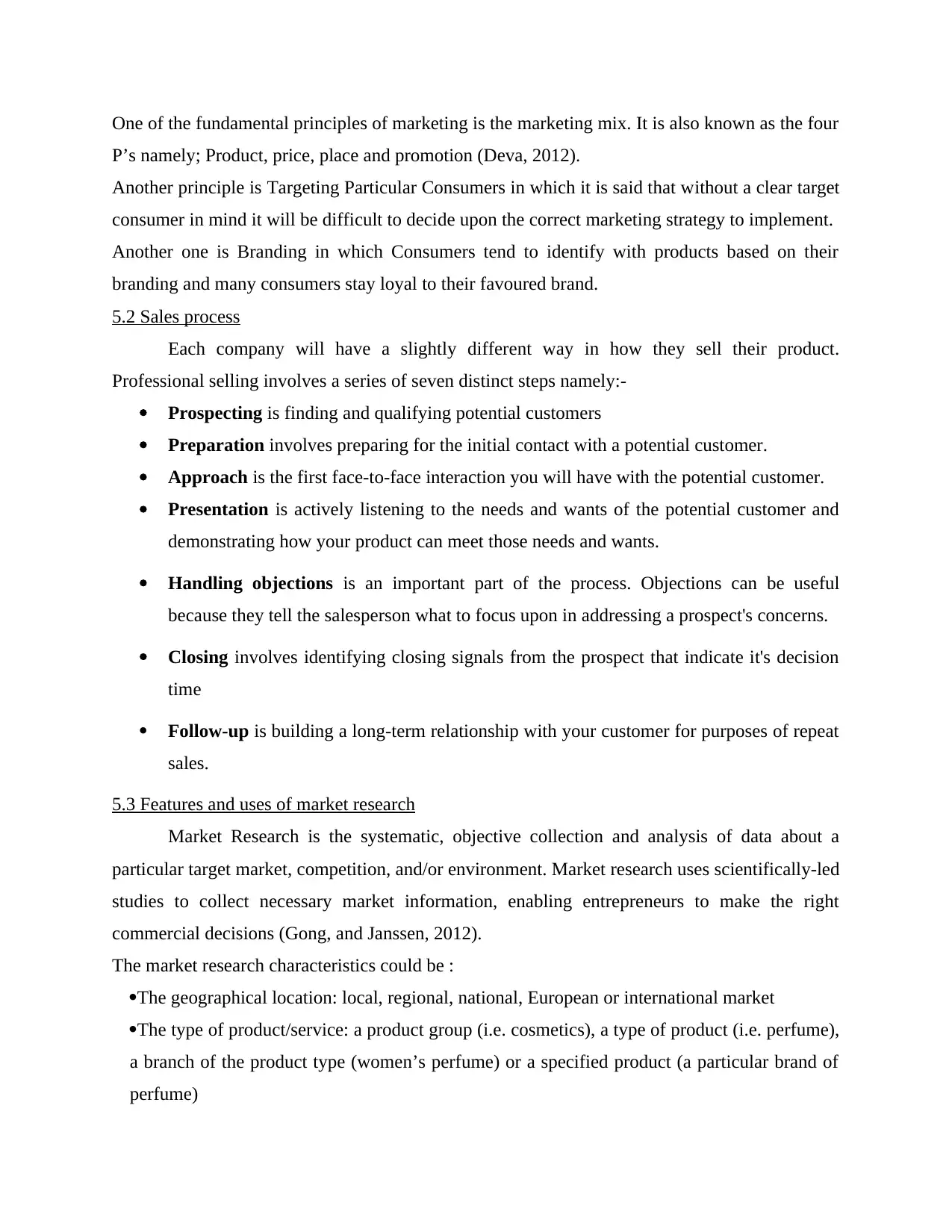
One of the fundamental principles of marketing is the marketing mix. It is also known as the four
P’s namely; Product, price, place and promotion (Deva, 2012).
Another principle is Targeting Particular Consumers in which it is said that without a clear target
consumer in mind it will be difficult to decide upon the correct marketing strategy to implement.
Another one is Branding in which Consumers tend to identify with products based on their
branding and many consumers stay loyal to their favoured brand.
5.2 Sales process
Each company will have a slightly different way in how they sell their product.
Professional selling involves a series of seven distinct steps namely:-
Prospecting is finding and qualifying potential customers
Preparation involves preparing for the initial contact with a potential customer.
Approach is the first face-to-face interaction you will have with the potential customer.
Presentation is actively listening to the needs and wants of the potential customer and
demonstrating how your product can meet those needs and wants.
Handling objections is an important part of the process. Objections can be useful
because they tell the salesperson what to focus upon in addressing a prospect's concerns.
Closing involves identifying closing signals from the prospect that indicate it's decision
time
Follow-up is building a long-term relationship with your customer for purposes of repeat
sales.
5.3 Features and uses of market research
Market Research is the systematic, objective collection and analysis of data about a
particular target market, competition, and/or environment. Market research uses scientifically-led
studies to collect necessary market information, enabling entrepreneurs to make the right
commercial decisions (Gong, and Janssen, 2012).
The market research characteristics could be :
The geographical location: local, regional, national, European or international market
The type of product/service: a product group (i.e. cosmetics), a type of product (i.e. perfume),
a branch of the product type (women’s perfume) or a specified product (a particular brand of
perfume)
P’s namely; Product, price, place and promotion (Deva, 2012).
Another principle is Targeting Particular Consumers in which it is said that without a clear target
consumer in mind it will be difficult to decide upon the correct marketing strategy to implement.
Another one is Branding in which Consumers tend to identify with products based on their
branding and many consumers stay loyal to their favoured brand.
5.2 Sales process
Each company will have a slightly different way in how they sell their product.
Professional selling involves a series of seven distinct steps namely:-
Prospecting is finding and qualifying potential customers
Preparation involves preparing for the initial contact with a potential customer.
Approach is the first face-to-face interaction you will have with the potential customer.
Presentation is actively listening to the needs and wants of the potential customer and
demonstrating how your product can meet those needs and wants.
Handling objections is an important part of the process. Objections can be useful
because they tell the salesperson what to focus upon in addressing a prospect's concerns.
Closing involves identifying closing signals from the prospect that indicate it's decision
time
Follow-up is building a long-term relationship with your customer for purposes of repeat
sales.
5.3 Features and uses of market research
Market Research is the systematic, objective collection and analysis of data about a
particular target market, competition, and/or environment. Market research uses scientifically-led
studies to collect necessary market information, enabling entrepreneurs to make the right
commercial decisions (Gong, and Janssen, 2012).
The market research characteristics could be :
The geographical location: local, regional, national, European or international market
The type of product/service: a product group (i.e. cosmetics), a type of product (i.e. perfume),
a branch of the product type (women’s perfume) or a specified product (a particular brand of
perfume)
⊘ This is a preview!⊘
Do you want full access?
Subscribe today to unlock all pages.

Trusted by 1+ million students worldwide
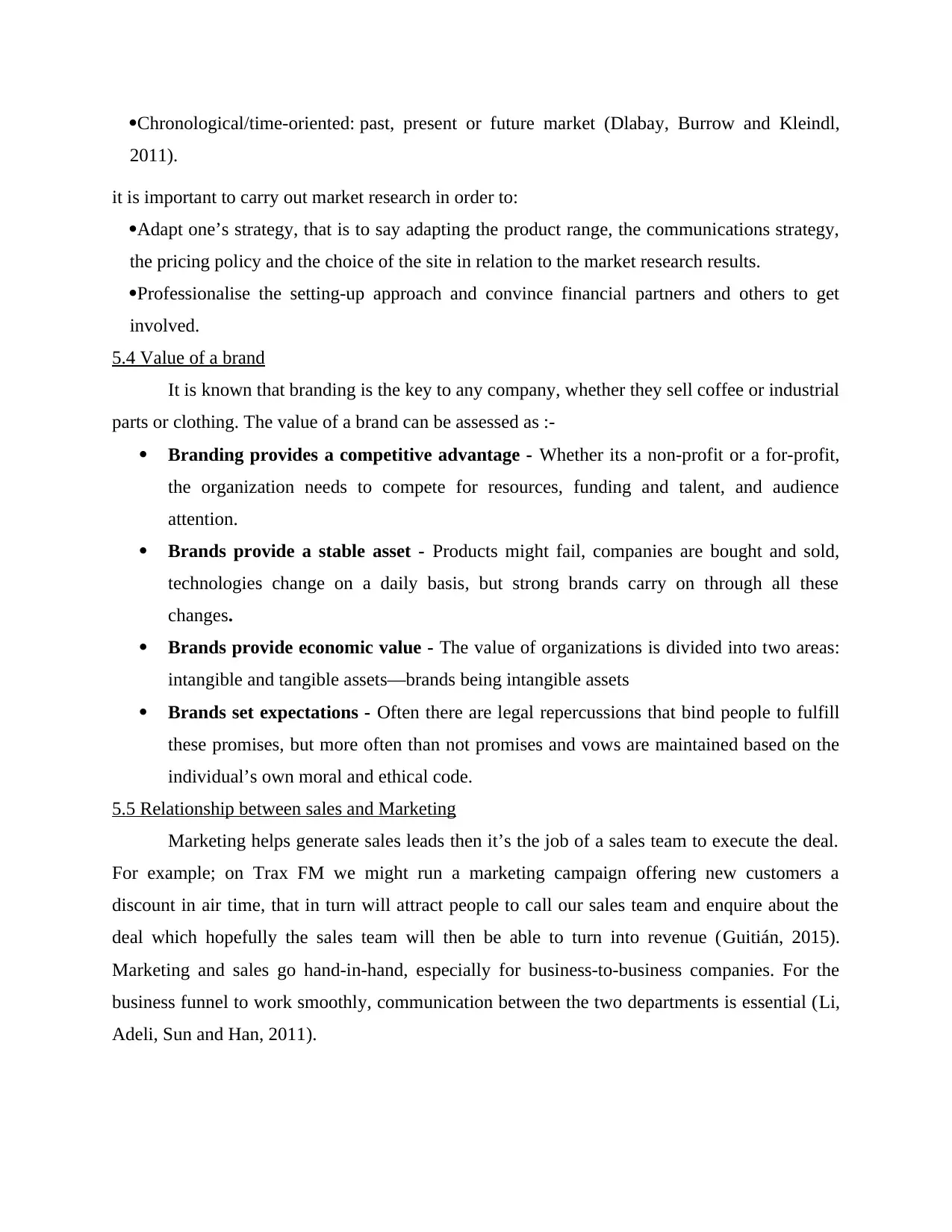
Chronological/time-oriented: past, present or future market (Dlabay, Burrow and Kleindl,
2011).
it is important to carry out market research in order to:
Adapt one’s strategy, that is to say adapting the product range, the communications strategy,
the pricing policy and the choice of the site in relation to the market research results.
Professionalise the setting-up approach and convince financial partners and others to get
involved.
5.4 Value of a brand
It is known that branding is the key to any company, whether they sell coffee or industrial
parts or clothing. The value of a brand can be assessed as :-
Branding provides a competitive advantage - Whether its a non-profit or a for-profit,
the organization needs to compete for resources, funding and talent, and audience
attention.
Brands provide a stable asset - Products might fail, companies are bought and sold,
technologies change on a daily basis, but strong brands carry on through all these
changes.
Brands provide economic value - The value of organizations is divided into two areas:
intangible and tangible assets—brands being intangible assets
Brands set expectations - Often there are legal repercussions that bind people to fulfill
these promises, but more often than not promises and vows are maintained based on the
individual’s own moral and ethical code.
5.5 Relationship between sales and Marketing
Marketing helps generate sales leads then it’s the job of a sales team to execute the deal.
For example; on Trax FM we might run a marketing campaign offering new customers a
discount in air time, that in turn will attract people to call our sales team and enquire about the
deal which hopefully the sales team will then be able to turn into revenue (Guitián, 2015).
Marketing and sales go hand-in-hand, especially for business-to-business companies. For the
business funnel to work smoothly, communication between the two departments is essential (Li,
Adeli, Sun and Han, 2011).
2011).
it is important to carry out market research in order to:
Adapt one’s strategy, that is to say adapting the product range, the communications strategy,
the pricing policy and the choice of the site in relation to the market research results.
Professionalise the setting-up approach and convince financial partners and others to get
involved.
5.4 Value of a brand
It is known that branding is the key to any company, whether they sell coffee or industrial
parts or clothing. The value of a brand can be assessed as :-
Branding provides a competitive advantage - Whether its a non-profit or a for-profit,
the organization needs to compete for resources, funding and talent, and audience
attention.
Brands provide a stable asset - Products might fail, companies are bought and sold,
technologies change on a daily basis, but strong brands carry on through all these
changes.
Brands provide economic value - The value of organizations is divided into two areas:
intangible and tangible assets—brands being intangible assets
Brands set expectations - Often there are legal repercussions that bind people to fulfill
these promises, but more often than not promises and vows are maintained based on the
individual’s own moral and ethical code.
5.5 Relationship between sales and Marketing
Marketing helps generate sales leads then it’s the job of a sales team to execute the deal.
For example; on Trax FM we might run a marketing campaign offering new customers a
discount in air time, that in turn will attract people to call our sales team and enquire about the
deal which hopefully the sales team will then be able to turn into revenue (Guitián, 2015).
Marketing and sales go hand-in-hand, especially for business-to-business companies. For the
business funnel to work smoothly, communication between the two departments is essential (Li,
Adeli, Sun and Han, 2011).
Paraphrase This Document
Need a fresh take? Get an instant paraphrase of this document with our AI Paraphraser

CONCLUSION
From the above report, it can be concluded that It is very important to use effective
business principles inside the organisation so as to address the problems that are prevailing in the
company.
From the above report, it can be concluded that It is very important to use effective
business principles inside the organisation so as to address the problems that are prevailing in the
company.
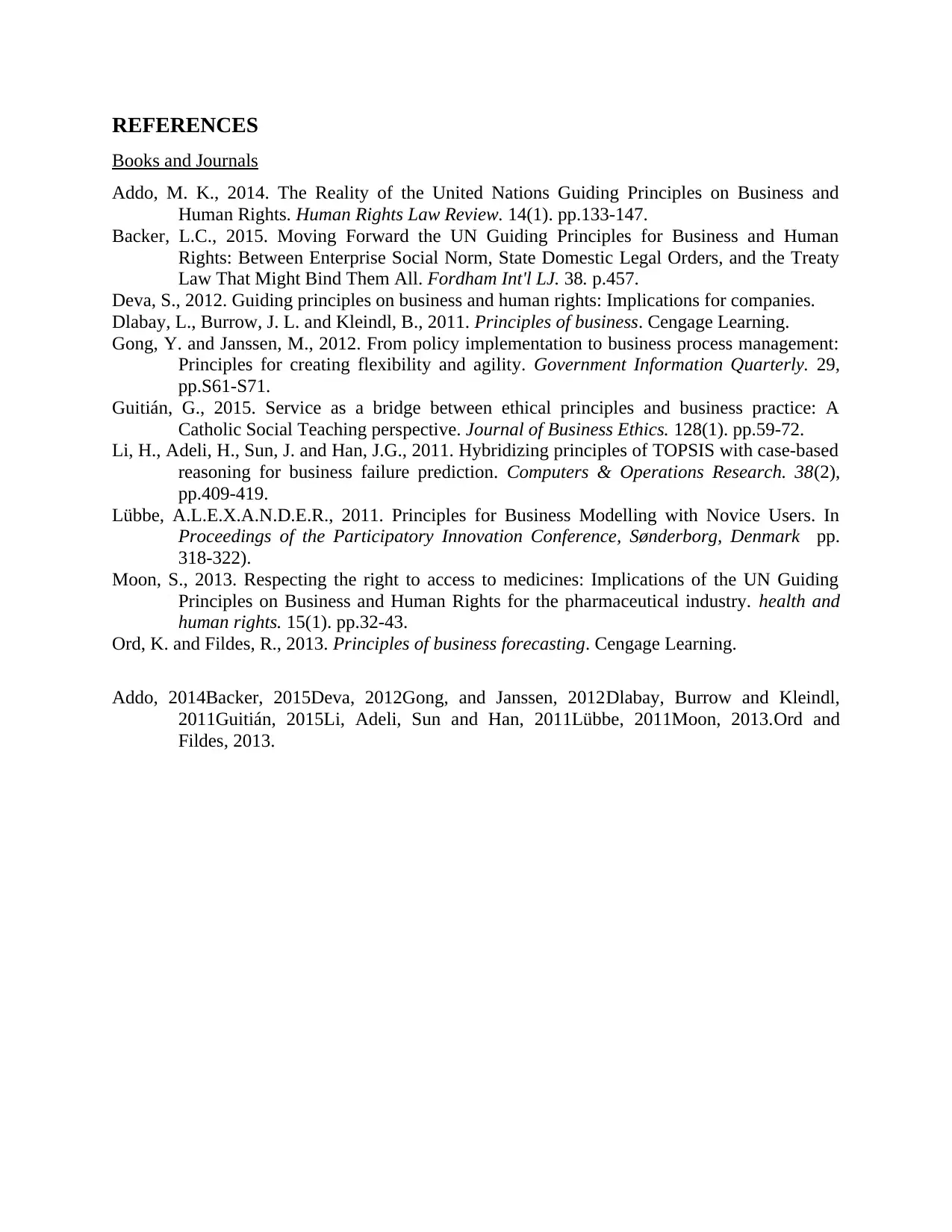
REFERENCES
Books and Journals
Addo, M. K., 2014. The Reality of the United Nations Guiding Principles on Business and
Human Rights. Human Rights Law Review. 14(1). pp.133-147.
Backer, L.C., 2015. Moving Forward the UN Guiding Principles for Business and Human
Rights: Between Enterprise Social Norm, State Domestic Legal Orders, and the Treaty
Law That Might Bind Them All. Fordham Int'l LJ. 38. p.457.
Deva, S., 2012. Guiding principles on business and human rights: Implications for companies.
Dlabay, L., Burrow, J. L. and Kleindl, B., 2011. Principles of business. Cengage Learning.
Gong, Y. and Janssen, M., 2012. From policy implementation to business process management:
Principles for creating flexibility and agility. Government Information Quarterly. 29,
pp.S61-S71.
Guitián, G., 2015. Service as a bridge between ethical principles and business practice: A
Catholic Social Teaching perspective. Journal of Business Ethics. 128(1). pp.59-72.
Li, H., Adeli, H., Sun, J. and Han, J.G., 2011. Hybridizing principles of TOPSIS with case-based
reasoning for business failure prediction. Computers & Operations Research. 38(2),
pp.409-419.
Lübbe, A.L.E.X.A.N.D.E.R., 2011. Principles for Business Modelling with Novice Users. In
Proceedings of the Participatory Innovation Conference, Sønderborg, Denmark pp.
318-322).
Moon, S., 2013. Respecting the right to access to medicines: Implications of the UN Guiding
Principles on Business and Human Rights for the pharmaceutical industry. health and
human rights. 15(1). pp.32-43.
Ord, K. and Fildes, R., 2013. Principles of business forecasting. Cengage Learning.
Addo, 2014Backer, 2015Deva, 2012Gong, and Janssen, 2012Dlabay, Burrow and Kleindl,
2011Guitián, 2015Li, Adeli, Sun and Han, 2011Lübbe, 2011Moon, 2013.Ord and
Fildes, 2013.
Books and Journals
Addo, M. K., 2014. The Reality of the United Nations Guiding Principles on Business and
Human Rights. Human Rights Law Review. 14(1). pp.133-147.
Backer, L.C., 2015. Moving Forward the UN Guiding Principles for Business and Human
Rights: Between Enterprise Social Norm, State Domestic Legal Orders, and the Treaty
Law That Might Bind Them All. Fordham Int'l LJ. 38. p.457.
Deva, S., 2012. Guiding principles on business and human rights: Implications for companies.
Dlabay, L., Burrow, J. L. and Kleindl, B., 2011. Principles of business. Cengage Learning.
Gong, Y. and Janssen, M., 2012. From policy implementation to business process management:
Principles for creating flexibility and agility. Government Information Quarterly. 29,
pp.S61-S71.
Guitián, G., 2015. Service as a bridge between ethical principles and business practice: A
Catholic Social Teaching perspective. Journal of Business Ethics. 128(1). pp.59-72.
Li, H., Adeli, H., Sun, J. and Han, J.G., 2011. Hybridizing principles of TOPSIS with case-based
reasoning for business failure prediction. Computers & Operations Research. 38(2),
pp.409-419.
Lübbe, A.L.E.X.A.N.D.E.R., 2011. Principles for Business Modelling with Novice Users. In
Proceedings of the Participatory Innovation Conference, Sønderborg, Denmark pp.
318-322).
Moon, S., 2013. Respecting the right to access to medicines: Implications of the UN Guiding
Principles on Business and Human Rights for the pharmaceutical industry. health and
human rights. 15(1). pp.32-43.
Ord, K. and Fildes, R., 2013. Principles of business forecasting. Cengage Learning.
Addo, 2014Backer, 2015Deva, 2012Gong, and Janssen, 2012Dlabay, Burrow and Kleindl,
2011Guitián, 2015Li, Adeli, Sun and Han, 2011Lübbe, 2011Moon, 2013.Ord and
Fildes, 2013.
⊘ This is a preview!⊘
Do you want full access?
Subscribe today to unlock all pages.

Trusted by 1+ million students worldwide
1 out of 12
Related Documents
Your All-in-One AI-Powered Toolkit for Academic Success.
+13062052269
info@desklib.com
Available 24*7 on WhatsApp / Email
![[object Object]](/_next/static/media/star-bottom.7253800d.svg)
Unlock your academic potential
Copyright © 2020–2025 A2Z Services. All Rights Reserved. Developed and managed by ZUCOL.





